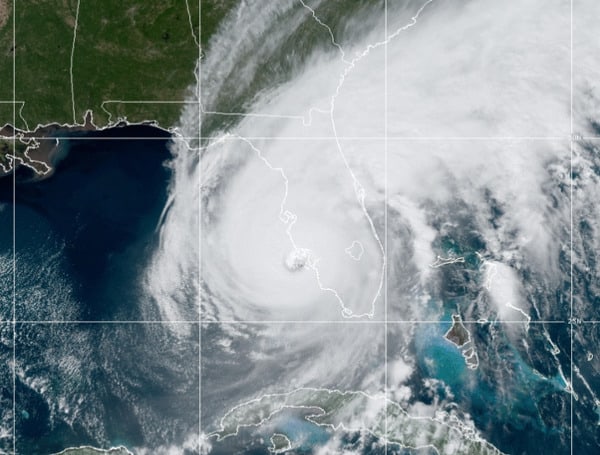As Hurricane Ian brought 155 mph winds Wednesday to Southwest Florida and was poised to cause damage across the state, 15 hospitals and 131 nursing homes and assisted living facilities had evacuated patients and residents, while other facilities “hunkered down.”
State Agency for Health Care Administration Secretary Simone Marstiller told reporters early Wednesday afternoon that about 350 hospital patients, 3,508 residents at 40 nursing homes, and 3,012 residents at 91 assisted living facilities had been evacuated.
Evacuating patients is a “significant undertaking” that includes transporting people by air and using ambulances, Florida Hospital Association CEO Mary Mayhew told The News Service of Florida.
“Many hospitals will locate their patients to their other sister facilities that are more removed from the storm’s path,” Mayhew said Wednesday. “But, of course, any disruption for patients as they’re being moved is handled with extreme care and caution to make sure that … their health and their condition is protected at all times.”
In the news: Video Shows Intense Strength Of Hurricane Ian As It Rips Through Florida
Mayhew said patients were being transported to facilities in Southeast Florida, as Ian was expected to go northeast into the center of the state after making landfall in Southwest Florida. It could exit the state around Daytona Beach.
The window of time for evacuations closes when wind speeds increase, said Mayhew, a former secretary of the Agency for Health Care Administration. As of Wednesday afternoon, the possibility of evacuation had essentially ended for some hospitals.
When hospitals face storms that are as intense as Ian, which was a Category 4 hurricane upon landfall, they evaluate “all aspects” of their facilities, according to Mayhew, and not every hospital needs to evacuate entirely.
“They’re going to look at opportunities to move their patients within the building into higher-level floors. But for any buildings that are older, or they may be single-story buildings, that’s what ultimately may contribute to the need to have evacuated,” Mayhew told the News Service.
The Agency for Health Care Administration, which regulates hospitals, nursing homes and assisted living facilities, requested facilities use an online reporting system to provide details such as evacuation status, patient and resident numbers, available beds and ability to generate backup power.
Several large hospitals appeared Wednesday to be in areas that could get hit hard by the storm.
As an example, Lee Health, which says it is one of the largest public-health systems in the U.S., operates four acute-care hospitals and two specialty hospitals in Southwest Florida.
Lee Health also is part of the Safety Net Hospital Alliance of Florida, which represents public, teaching and children’s hospitals. Justin Senior, the alliance’s CEO, said none of the hospitals that are members of his organization had evacuated, including Lee Health.
“So they’re (Lee Health) really, I’m sure, hunkered down right now, waiting for this thing to pass over,” Senior said.
The alliance includes other large hospitals likely to be affected to varying degrees, including Orlando Health, the Sarasota Memorial Health Care System, Johns Hopkins All Children’s Hospital in St. Petersburg, Tampa General Hospital and Halifax Health in Daytona Beach..
“We have several (hospitals) that are going to be, ultimately are, (in) a direct line right now (with the storm). And then several others that will come into the line of the hurricane, we’d expect, in the next 24 to 36 hours,” said Senior, also a former secretary of the Agency for Health Care Administration.
Senior pointed to sophisticated emergency-management plans that hospitals maintain and said communication with the state is key to their storm response.
“Every hospital is going to make sure that it has (electricity) generating capacity, fuel for the generators, food and water and is communicating with the state about what is functioning, what is not functioning and what its needs are,” Senior said.
State officials were expecting wide-ranging power outages from the storm. During a 1 p.m. media briefing, Gov. Ron DeSantis said 200,000 power outages had been reported. He called that a “drop in the bucket” compared to the number expected later.
Hospitals in some situations receive additional patients after storms, and the state has staged resources to be able to get people to facilities if they are injured in the hurricane.
AHCA has put about 400 ambulances, paratransit buses and support vehicles on standby to respond to areas damaged by the hurricane, state officials said Wednesday.
After the storm passes, hospitals and industry associations will coordinate with state officials to transport patients back to their facilities.
DeSantis said during a media briefing Wednesday that he wants evacuees to be returned to their facilities as soon as the storm is no longer a threat.
“Particularly in the Tampa area, I know we had a lot of special-needs evacuations, as we should have,” the governor said. “And they’re going to feel effects from this. But my hope is that those patients are going to be able to be brought back as soon as the storm has passed.”
Visit Tampafp.com for Politics, Sports, and National Headlines. Support journalism by clicking here to our GiveSendGo or sign up for our free newsletter by clicking here.
Android Users, Click Here To Download The Free Press App And Never Miss A Story. Follow Us On Facebook Here Or Twitter Here.
Copyright 2022 The Free Press, LLC, tampafp.com. All rights reserved. This material may not be published, broadcast, rewritten, or redistributed.


